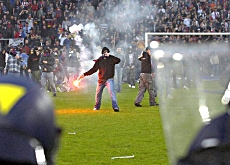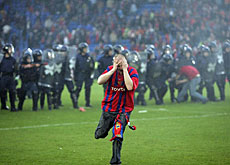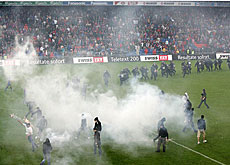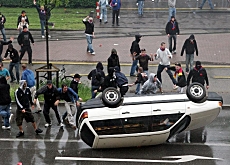Portrait of a football hooligan

Who are the violent supporters behind the shocking scenes that followed last Saturday's dramatic finale to the football season between FC Basel and FC Zurich?
According to two Swiss experts, those responsible for the violence inside and outside Basel’s St Jakob stadium are young, integrated into society and apolitical.
Many people believe that violent football supporters are outsiders with links to the far right, but Thomas Busset, a sociologist from the International Centre for Sports Studies at Neuchâtel University, says a “typical” violent fan is integrated both socially and professionally and usually does not hold any political affiliations.
As part of his research for the Swiss National Science Foundation into rightwing extremism and football, Busset followed supporters from three Swiss clubs – FC Basel, FC Servette and Young Boys Bern – and interviewed them about their motivations, backgrounds and political beliefs.
“We found that violent supporters do not belong to a particular social group, something that has been confirmed by other studies both here in Switzerland and abroad,” he said.
No inhibitions
Busset believes the profile of a typical hooligan has altered considerably over the past few decades.
“When football hooligans first appeared in England in the 1960s, they were mostly apolitical working-class lads,” he explained.
“Over the next 20 years, far-right circles tried but failed to recruit large numbers of people at football matches.”
Those involved in hooliganism are now also much younger. And whereas the older ones are still bound by certain unwritten fighting rules, the “new” violent supporters have no inhibitions.
“Fights used to be between groups of roughly the same size and anyone who fell to the ground was left alone – these rules are no longer respected.”
Two sides
Busset says there are two kinds of violent supporter: hooligans and hardcore fans.
“The first are related to the ‘English model’,” he said. “Violence is the most important thing for them. Their aim is to have a fight. Sometimes they even organise to meet rival supporters outside a stadium to fight.”
The second group has an “emotional connection” to football. They support their team, create atmosphere in the stadium and react to events during a match. “If their team is losing, they might try to re-establish the hierarchical order by invading the pitch,” said Busset.
Busset believes last Saturday’s events at Basel were the responsibility of hardcore fans.
“The violence was not planned,” he said. “The Basel fans came to the match with the idea that their team was going to win. When things turned against them, they reacted violently. They expressed their disappointment by attacking the opposing side’s players.”
According to Ueli Mäder, a Basel sociologist, “such outbreaks of violence always compensate for their frustrations and the lack of opportunities in their daily lives. For them, victory is the most important thing and defeat really is a disaster”.
He added: “A culture based on competition focuses on the idea of victory. But this is not just in football. Violence is increasingly part of society. It is establishing itself as a model for young people.”
swissinfo, Alexandra Richard
Saturday’s finale to the football season descended into violence after FC Zurich snatched the title from Basel in the last seconds of the game.
Around 100 people were injured, 15 taken to hospital, and some 25 arrests were made. Damage to the St Jakob stadium has been estimated at SFr500,000.
With Switzerland poised to co-host Euro 2008, the Swiss parliament has voted through legislation to ban hooligans from grounds, restrict travel, compile a database of hooligans and increase powers of arrest.
On Friday Peter Stadelmann, president of the Swiss Football League, confirmed that Swiss clubs and the league were firmly behind the new laws intended to stamp out hooliganism. Security will be stepped up in Swiss stadiums, he said.
Classification of supporters according to sociologist Ueli Mäder:
Type A: They support their team and behave normally. They are the majority of fans.
Type B: They are often members of a fan club. During matches they wave flags and sometimes boo the referee or the opposing players but do not fight.
Type C: Hooligans.

In compliance with the JTI standards
More: SWI swissinfo.ch certified by the Journalism Trust Initiative



You can find an overview of ongoing debates with our journalists here. Please join us!
If you want to start a conversation about a topic raised in this article or want to report factual errors, email us at english@swissinfo.ch.